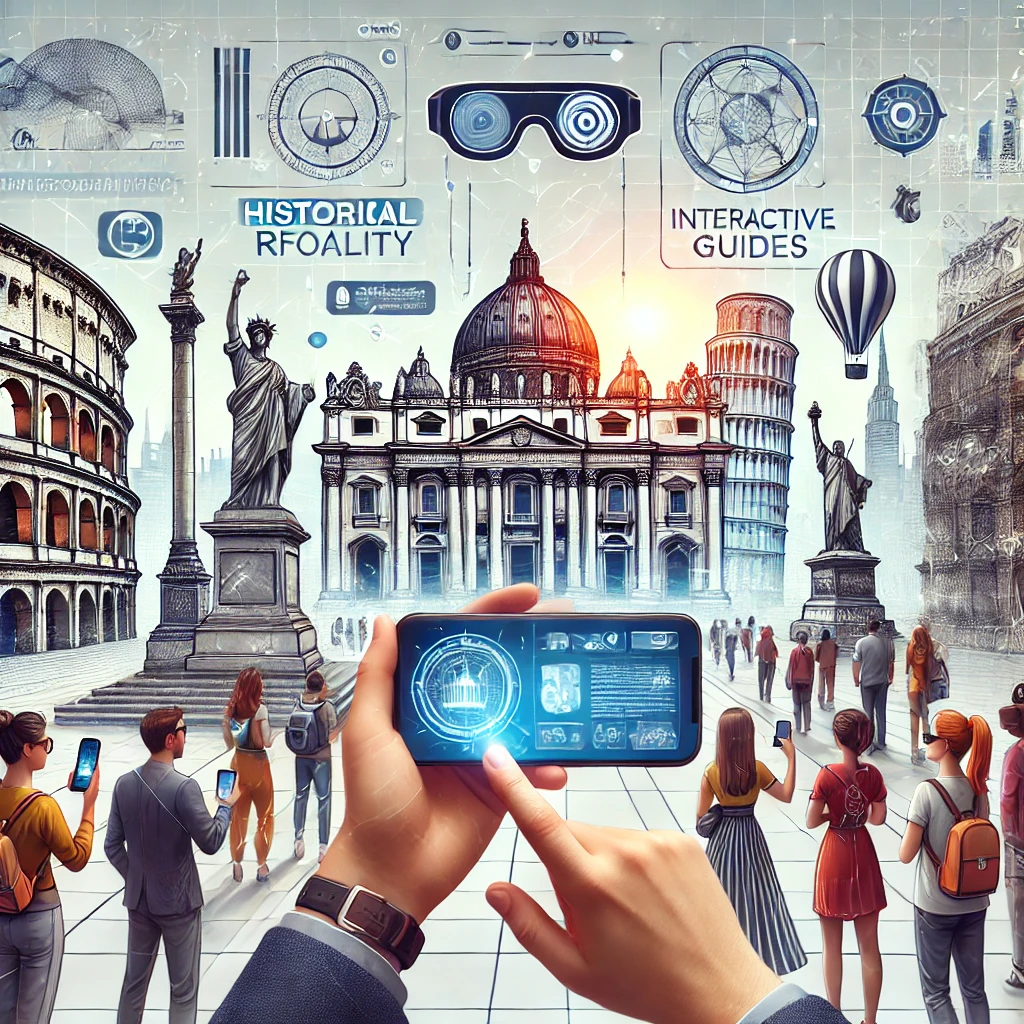The future of medicine is being transformed by augmented reality (AR). This innovative technology promises to revolutionize healthcare, providing new opportunities and enhancing how medical professionals diagnose and treat diseases.
Augmented reality combines the virtual world with the real world, allowing doctors to view medical information in real-time and interactively. Imagine a surgeon using an AR headset to see medical images overlaid on the patient’s body while performing an operation. This tool enables improved precision and planning, leading to safer and more successful outcomes.
Beyond surgery, augmented reality is also used in medical training, allowing students to practice complex techniques and simulate procedures before performing them in real settings.
Undoubtedly, the impact of augmented reality in healthcare is promising. As this technology continues to evolve, we can expect significant advancements in diagnostics, treatment, and medical education. It’s clear that the future of medicine is here, and augmented reality is leading the way toward more precise and efficient healthcare.
What is Augmented Reality in Healthcare?
Augmented reality (AR) is a technology that overlays digital information onto the user’s physical environment, creating an interactive and enriched experience. In healthcare, this tool is used to enhance the visualization of medical data and the interaction with patients and their conditions. Through devices like smart glasses, tablets, or smartphones, healthcare professionals can access critical information while performing clinical or surgical procedures.
AR enables doctors to view three-dimensional images of organs and internal body structures in real-time. This is particularly useful in complex situations, such as during surgery, where precision is essential. With augmented reality, surgeons can see graphic representations of tissues, blood vessels, and tumors, helping them make more informed decisions and minimize risks.
Additionally, AR extends beyond surgery and into medical education and professional training. Medical students and residents can use AR simulations to practice surgical techniques and clinical procedures in a controlled environment, allowing them to acquire skills without risking patient safety. In this sense, augmented reality positions itself as a versatile and essential tool in modern medicine.
Advantages of Augmented Reality in Medicine
One of the main advantages of augmented reality in medicine is improved precision in medical procedures. By allowing doctors to overlay visual information onto the work area, AR reduces the likelihood of human error and enhances the ability of professionals to perform complex interventions confidently. This is especially relevant in fields like neurosurgery, where a small margin of error can have significant consequences.
Another advantage is the optimization of time during procedures. AR can speed up the diagnostic and treatment process by providing instant and relevant information. For example, during an operation, surgeons can access data about the patient’s anatomy without consulting multiple sources, allowing them to act more quickly and effectively. This not only improves the patient experience but also contributes to more efficient use of hospital resources.
Moreover, augmented reality offers a more engaging and educational experience for both healthcare professionals and patients. Doctors can better explain procedures and diagnoses to their patients using interactive visualizations, facilitating understanding and fostering confidence in treatment. The ability to see a visual representation of their condition can help patients feel more involved in their healthcare, improving communication between doctor and patient.
Statistics on Augmented Reality in the Healthcare Sector
Statistics on the adoption of augmented reality in healthcare are impressive and reflect continuous growth in its implementation. According to recent studies, the AR market in healthcare is expected to reach a value of over $2.4 billion by 2026, with a compound annual growth rate (CAGR) of 30.2%. This growth is driven by the increasing demand for advanced technologies that improve healthcare and professional training.
Additionally, AR use in medical training has been found to increase knowledge retention among students by 70% compared to traditional teaching methods. This suggests that students who use augmented reality simulations are more likely to remember and apply what they have learned in real clinical situations. This statistic highlights AR’s effectiveness as an educational tool in medicine.
Another study showed that 80% of surgeons who used augmented reality technology during surgical procedures reported improved precision and efficiency in their interventions. These statistics underscore the positive impact of augmented reality not only in the training of healthcare professionals but also in daily clinical practice, suggesting that its integration in medicine is a trend that will continue to rise.
Applications of Augmented Reality in Medicine
The applications of augmented reality in medicine are diverse and span multiple areas, from surgery to rehabilitation. In the surgical field, AR is used to visualize medical images, such as CT scans or MRIs, within the operation area, enabling surgeons to plan and execute procedures with greater precision. For instance, in orthopedic surgeries, doctors can see the exact position of implants during the operation, minimizing the risk of complications.
In medical education, augmented reality has become an invaluable tool for student and professional training. Through applications that simulate surgical procedures, aspiring doctors can practice in a virtual environment before facing real-life situations. This hands-on learning method not only increases student confidence but also reduces the risk of errors during their initial clinical experiences.
Augmented reality is also used in patient rehabilitation. Some applications allow therapists to create personalized exercises that patients can perform at home, where AR provides visual feedback and guidance throughout the process. This not only improves patient adherence to their treatment but also makes rehabilitation more interactive and motivating.
How to Implement Augmented Reality in Your Medical Practice
Implementing augmented reality in a medical practice requires careful planning and a strategic approach. First, it is essential to assess the practice’s specific needs and determine how AR can address these challenges. This may involve identifying areas where precision and data visualization are crucial, such as in surgery, education, or rehabilitation.
Once the key areas are identified, the next step is to select the appropriate technology. Different AR devices and platforms are available, from smart glasses to smartphone applications. It’s essential to choose a solution that fits the needs of the medical staff and integrates easily with existing medical information management systems.
Training staff is another critical aspect of implementing augmented reality. Doctors and support staff should receive training on effectively using the technology to maximize its benefits. This may include workshops, online courses, or practical training sessions that allow them to familiarize themselves with the tools and gain confidence in their use.
Tips for Using Augmented Reality in Healthcare
To make the most of augmented reality in healthcare, a careful and strategic approach is necessary. An important tip is to start with pilot projects that allow testing the technology in a controlled environment. This will enable healthcare professionals to experiment with AR and evaluate its effectiveness before implementing it on a larger scale.
Moreover, it’s essential to foster collaboration across different disciplines. Augmented reality can be more effective when used in conjunction with other technologies and approaches. For example, combining AR with artificial intelligence or data analytics can provide even deeper insights and improve medical decision-making.
Finally, it is essential to keep the patient at the center of the process. When using augmented reality, doctors should ensure that the patient experience is positive. This involves clearly communicating how the technology will be used and what benefits they can expect. Including the patient in the process can improve trust and overall satisfaction with healthcare.
Best Augmented Reality Tools for Healthcare Professionals
There are several augmented reality tools designed specifically to enhance healthcare. One of the most recognized is Microsoft HoloLens, which allows surgeons to view 3D medical images overlaid on the patient’s body during operations. This tool has been used in various medical institutions and has proven effective in improving surgical precision.
Another prominent tool is Magic Leap, which offers immersive AR experiences for medical education. This platform allows medical students to interact with anatomy and procedure simulations, facilitating practical learning and information retention. Its intuitive design and visual quality make it a popular choice in education.
Lastly, applications like Augmedix and Proximie are gaining popularity among physicians. Augmedix uses AR to help doctors document patient interactions in real-time, while Proximie enables surgeons to collaborate and consult experts in real-time through an AR platform. Both tools are designed to improve healthcare efficiency and quality, leveraging augmented reality’s advantages.
Courses and Training in Augmented Reality for Doctors and Specialists
With the growing adoption of augmented reality in medicine, numerous training opportunities for doctors and specialists have also emerged. Several institutions offer online and in-person courses that address AR use in healthcare. These courses typically cover both theory and practice, allowing participants to understand the technology’s fundamentals and how to apply it in their daily work.
For instance, some universities and medical schools have developed specific programs on using augmented reality in medical education. These programs include modules on human anatomy, surgical procedures, and interactive simulations, providing students with a comprehensive and enriching experience.
Additionally, health sector organizations and conferences are beginning to include workshops and sessions on augmented reality. These opportunities allow healthcare professionals to connect with experts in the field and learn about the latest trends and advances in AR use in medicine. Continuous training is essential to stay updated in this rapidly evolving field.
Augmented Reality Services in the Medical Field
Numerous companies are emerging in the augmented reality field to offer specialized services to healthcare institutions. These services range from developing customized applications to consulting on implementing AR solutions. For instance, some companies develop specific software for medical visualization that enables doctors to view complex data more clearly and accessibly.
Other companies focus on creating AR simulations for medical training. These services allow educational institutions to offer students immersive and practical learning experiences. Simulations can range from surgical procedures to patient care, providing comprehensive training that prepares future healthcare professionals to face real-world challenges.
Finally, some AR services are designed to improve the patient experience. These applications can help patients better understand their condition and treatment by offering interactive visualizations that facilitate communication with doctors. By enhancing patient understanding, these services can contribute to better treatment adherence and improved health outcomes.
Conclusion: The Promising Future of Augmented Reality in Healthcare
The future of medicine is intrinsically linked to technology evolution, and augmented reality stands out as one of the most promising innovations in this field. As AR continues to develop, we can anticipate significant changes in diagnosing, treating, and educating within the healthcare sector. The ability to visualize medical information in real-time and interactively will not only enhance the precision and efficiency of medical procedures but also transform the doctor-patient relationship.
Training and education opportunities in augmented reality use are on the rise, allowing more healthcare professionals to benefit from this technology. The practical applications of AR, from surgery to rehabilitation and medical education, highlight its versatility and potential to revolutionize healthcare.
In summary, augmented reality is not just a passing trend; it represents a new era in medicine that promises to improve healthcare quality and the patient experience. With a continued focus on innovation and education, the future of medicine will be enriched by augmented reality, paving the way for more precise and efficient healthcare.


